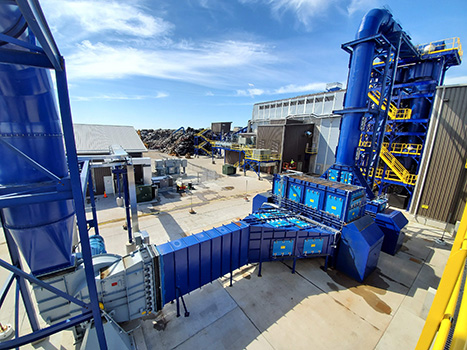
In recent years, the EPA and state and local regulatory agencies have increasingly focused on the air pollutants emitted from scrap metal shredding and recycling operations. These pollutants include particulate matter (PM), volatile organic compounds (VOCs), acid gases, and other air contaminants.
Facilities that shred autos in particular have regulators increasingly enforcing low emission limits for particulate matter (Total Particulate Matter, PM10, and PM2.5) and also for VOCs and acid gases. With regard to particulate matter, the particulate emitted from shredders includes oil, other hydrocarbons, water and other liquids that evaporate in the heat of the shredding process and then condense in the air exhausted from the shredder as it cools. (Organic material that volatilizes in the shredder, or further downstream in the material flow, but does not condense in the exhaust gas creates the VOCs in the exhaust.) The fine condensed droplets, combined with many types of solid dust particles and fluff from the shredder, form a messy, oily, particulate problem. Robust equipment that provides high-efficiency removal of all particulate sizes, including submicron sizes, is required.
APC has designed and provided systems to successfully address particulate matter emissions at auto & scrap metal recycling facilities since 2006, with successful systems operating in the United States, Canada, Australia, and New Zealand. Owners have mainly selected APC’s cyclones combined with an Ultra High-Efficiency Filter (UHF®) unit to accomplish their particulate control requirements, as this equipment is more effective at removing fine PM, more energy-efficient, and generates less secondary waste than other options. However, APC also furnishes venturi (wet) scrubbers for PM removal where owners wish to use that technology. A case study is available here for more details on particulate matter control at an auto & scrap metal recycling plant.
In addition to providing particulate matter emission control equipment, APC also provides acid gas emission control systems and mercury emission control systems for scrap metal recycling facilities. Acid gases, commonly HCl and HF, often originate from refrigerants and fluorocarbons that are in blown foam insulations, but also can be present in certain rubber parts in autos and appliances, which then become acid gases mainly in downstream oxidizers (which are used destroy the VOCs). APC offers both dry sorbent injection systems (with a baghouse) and wet scrubbers for the acid gases.
If/where mercury control is required, APC offers both dry powdered activated carbon injection systems (with baghouse) and fixed media bed systems for smaller gas flow rates. Where both acid gas and mercury control are required, significant savings are realized by using one or two injection systems and a single baghouse, versus a wet scrubber for acid gases and then a complete additional system for mercury removal.
Equipment/technology selection depends on air permit limits, existing controls and utilities at the site, and site environmental conditions among other factors, along with Owner preferences of course. APC can quote multiple options where more than one option is feasible.